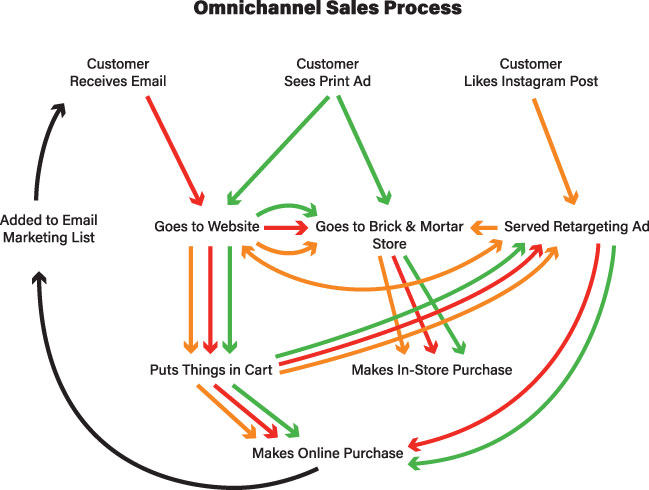11/1/2018
Communication in the Age of Omnichannel
Katie Elzer-Peters

Communications to retail customers before ecommerce meant selling one thing to many people using the same message. Omnichannel retail (in a post-ecommerce world) is selling one thing to one person through a continuous, personalized flow of communications across multiple channels from first point of contact with a customer to the point-of-sale (with that one customer)—and beyond. In truth, “SELLING” is superseded by the end-to-end omnichannel communications process.
This sounds like a lot of work and it can be if not properly planned with a unified strategy. In fact, when executed well, it’s actually a way to streamline and harmonize the entire sales process so that every input—inventory, staff time and marketing messages—all function synergistically instead of haphazardly.
“Omnichannel done right helps retailers get more from their marketing budgets, increase customer transactions and receive more money from their customers,” says Clint Albin, chief communications officer, Bower & Branch. “Nordstrom found customers who shop via multiple channels are twice as profitable to the company and spend up to five times as much money as single-channel shoppers. It’s a result that can be replicated by independent retailers who make a management decision to deploy the right tools, educate themselves on the process and get buy-in from their staff.”
Out with the Old
Everything about previous sales cycles in horticulture revolved around the product. Manufacturers introduced new products at the summer trade shows, then buyers made their decisions. Orders were placed. Marketing campaigns were created once product was in hand. Whether consumers wanted something or not, product was pushed out to them. Ad campaigns would encourage people to come buy, they either would or wouldn’t, and the cycle would start over.
Omnichannel sales cycles revolve around the consumer: where he is, what she’s interested in, how he likes to communicate, how she does research, how he makes purchasing decisions and her behavior after a purchase. It involves looking at data and trends to care for customers and plan for their future purchases. There’s no “start to the year” anymore. Conversations are ongoing and so is the sales cycle.
Consumer behavior differs between age groups. Millennials might shop more online, however, according to omnichannel research firm Profitect, members of Generation Z (which will comprise 32% of the world’s population by 2019, outnumbering Millennials), prefer to stop in store. There’s a caveat, though. Profitect reports, “Product availability is an important factor for Gen Zers, with 60% of respondents always or sometimes checking a store’s in-store inventory availability online before going to make a purchase.” (There’s your omnichannel strategy at work.)
The study continues, “One in five Gen Zers (20%) would never shop at the retailer again if a website said a product was available in-store, but it was actually out of stock. Given this finding, retailers should invest in solutions that ensure stock is up to demand and that websites accurately reflect in-store inventory.”
Putting the Pieces Together
The omnichannel strategy directly connects communications to commerce. The conversation and sales cycle flows through multiple touchpoints based on activities the customer has initiated rather than feeding disparate beasts (channels) or a list of tactics that might be completely irrelevant to the customer.
Pre-omnichannel, a tactic such as “Post on Instagram once per day,” was a common metric or deliverable for a marketing manager. Within an omnichannel strategy, this becomes a useless tactic if it isn’t demonstrably connected to the sales cycle with click-and-buy features, calls to actions or ways to encourage engagement. Every action a customer takes opens a new pathway to the end sale, a pathway customized for that individual customer.
 Pictured: Here are the many ways a customer can find out about your operation and shop it in a successful omnichannel retail situation.
Pictured: Here are the many ways a customer can find out about your operation and shop it in a successful omnichannel retail situation.
Behavioral Data
Each time customers take an action, they’re giving retailers and manufacturers crumbs of data to examine, refine and use to further personalize the customer experience and enhance the product offerings. Here’s data you can use to tailor the customer experience:
* Email open rates correlated to the device used. Did they open on mobile, tablet or desktop? What browser? What was the subject line that interested them? How was the A/B testing function used?
* Instagram post “likes”
* Visits to one webpage versus another
* Purchasing behavior, including abandoned carts or use of coupons (in store or online)
* Multi-channel purchasing behavior such as ordering online and picking up in store
While it can seem difficult for individual businesses to analyze the data and deploy the appropriate strategies on their own, it’s foundational to the next age of retailing to increase customers and profits.
All of the data and all of the personalized calls-to-action in the world are moot if marketing messages don’t connect to current, accurate inventory and/or lead to future inventory decisions, though, which drives home the necessity for true integration between marketing, sales and inventory.
Creating Vital Connections
The communications chain connecting the pedal to the wheels in the omnichannel strategy is customer service. This comes in a variety of forms, from direct communication in the form of answering questions to availability of checkout options. It’s worth repeating: The omnichannel strategy connects communication to commerce, guiding consumers as they chart their own path to purchase.
Good customer service ends up being practically invisible, allowing customers to seamlessly navigate through the sales cycle. Bad customer service, however, takes a huge toll. In the Gen Z survey, it was revealed that the demographic likes to research on their own before making purchase decisions, but “more than half of the total respondents (57%) said poor customer service would be the biggest reason for them to stop shopping at a favorite retailer.”
Clint says, “If there were a way to sum up omnichannel retail, it would be reducing communication gaps and friction. Making it easy, pleasant and trouble-free for a customer to get what they want, how they want it, when they want it.”
It seems like an impossible task, but with the right tools, it’s achievable and profitable.
Bower & Branch is a horticulture brand that meets consumers 365 days a year where they live, work, garden and nurture themselves and their families. B2 provides the tools for IGCs to be onmichannel present.
Customer service communications is the linchpin of omnichannel strategy
Old-school customer service is picking up the phone or in-person communication. Omnichannel customer service is all about giving options during the sales process, including potentially:
• Order online; pick up in store
• Self-checkout
• Mobile checkout
• Coupons that can be redeemed via smartphone or printout
• Promotions and emails relevant to a customer’s demonstrated interests
• Accurate online inventory and information about product specifications
• In-store Wi-Fi so that consumers can continue to research purchases onsite
• Email, social or text reminder strategy based on previous purchasing behavior
• Clear explanation of traditional customer service help available GP